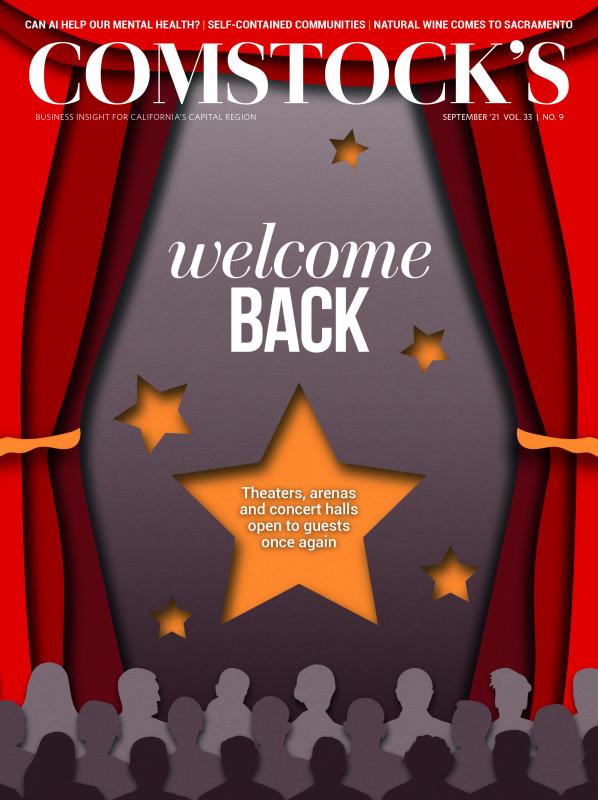As near as they can figure, Julie Morehead and Andrew Ryback say the grand opening of Bank of Feather River’s new building in downtown Yuba City was the moment they started talking seriously about joining their community banks. Ryback is president and CEO of Quincy-based Plumas Bank, and Plumas was making upgrades to some of its own branches, so he was looking for ideas. Morehead was president and CEO at the Bank of Feather River. On that early May day in 2019, Ryback stopped by to take a look.
The companies already shared a heritage: In 1821, Spanish explorer Luis Antonio Argüelo named the big river in the area for the many birds he saw on the water: El Rio de las Plumas, later Feather River. A tributary that feeds that river starts near Quincy, and about 120 miles downstream the river flows through Yuba City, passing not far from Morehead’s building.
When the pandemic hit, they put their merger talks on hold to focus on getting federal loans out the door to struggling businesses. But this March, they formalized the plans, and Feather River formally became part of Plumas on July 1. Morehead stepped down as CEO to join the Plumas board, while the rest of the staff kept their jobs.
Also in March came news of a different kind of merger: San Francisco fintech firm SoFi announced that it was buying Sacramento-based Golden Pacific Bank and its three branches. SoFi offers residential and student loans, which will be brand-new products for Golden Pacific’s customers, says Golden Pacific President and CEO Virginia Varela, who will continue to lead her bank under the deal.
Spring is for marriages, and at least three other area banks announced new partnerships as the weather turned warm. Northern California National Bank in Chico reported in March it was being bought by a group of investors. In April, Rancho Cordova-based American River Bank signed a merger agreement with Bank of Marin and finalized the deal in August. In June, Merchants Bank of Commerce, whose holding company is located in Sacramento, said it was being acquired by the larger Columbia State Bank in Washington.
All that may sound like a sudden merger mania, but it’s part of a 35-year trend. The number of banks has fallen from more than 18,000 in 1985 to fewer than 5,200 in 2019. Attrition has been most severe among the smallest banks, those with less than $10 billion in assets: Their share of total assets shrank from 55 percent in 1995 to about 16 percent in 2018. That worries some bankers and banking experts: As community banks continue to be swallowed by bigger fish, some of them say it could put small-business lending at risk.
Growth Through Credit Cards?
The shakeout could have big implications for the country’s small businesses. Community banks are defined by the U.S. Small Business Administration as locally owned and operated and having less than $10 billion in assets. That group may hold only 16 percent of total assets — but they made 42 percent of the total value of small business loans in 2019, according to the SBA.
Edward Carpenter is chairman and CEO of Newport Beach-based Carpenter & Company, which has advised on hundreds of bank startups since 1997. He forecasts that in the next five years bank numbers will fall further to about 4,000 — another 20 percent drop — and he worries too few community banks will be left to meet the demand for small-business capital. Small loans “aren’t economical for the large banks — the profit margins aren’t there,” says Carpenter. “But they are for smaller banks that don’t have these huge infrastructures, these huge overheads.”
He’s seeing the disappearance of smaller banks leading more entrepreneurs to finance their growth through credit cards — at 14- to 18-percent interest — instead of through bank loans at the prime rate of about 3 percent plus 2 percent (as of July). Indeed, SBA’s numbers already show an 11 percent drop in the number of small-business loans made nationally from 2017 to 2019.
“If you’re a business in Sacramento, how important are you going to be to one of the megabanks versus a local bank that’s going to give you more attention?”
Stephen Fleming, president and CEO, River City Bank
Community banks also give customers access to bank decisionmakers in a way larger banks can’t, says Stephen Fleming, president and CEO of River City Bank (and a member of Comstock’s Editorial Advisory Board). “If you’re a business in Sacramento, how important are you going to be to one of the megabanks versus a local bank that’s going to give you more attention?” he asks. “Being important in your relationship matters.”
Malcolm Hotchkiss, Golden Pacific executive vice president and chief operating officer, also has concerns, though not about Golden Pacific’s ability to serve its small-business customers post-acquisition. He worries about fewer community bank loans to small businesses driving them to fintech lenders like Kabbage, which lends through an online platform. “If I were to go to Kabbage and borrow money, it’s very expensive money, but I can get it right away. … But that’s a transaction rather than a relationship,” says Hotchkiss.
A Decade of No New Banks
Several market pressures are driving the plunge in numbers. The Federal Reserve’s bottom-basement interest rate policy, in place since the 2008 recession, has flattened bank profits, says Randall Eslick, president and CEO of Merchants Bank. As younger people open accounts, firms also feel more pressure to consistently invest in new technology — online loan applications, automated loan underwriting, new mobile banking apps and more.
Even big banks are making big-tech spends: Giant JPMorgan Chase & Co. says it’s shelling out $11 billion a year on a team of 50,000 tech developers. And when bank giants BB&T and SunTrust announced a merger in 2019, the prime reason was to pour more money into new tech. Interest rates and tech demands “are the primary drivers right now of bank consolidation,” says Eslick. “And they really result in the need for scale.”
“(Interest rates and tech demands) are the primary drivers right now of bank consolidation, and they really result in the need for scale.”
Randall Eslick, president and CEO, Merchants Bank
A longtime bank executive mentions another challenge: the ongoing cost of the additional rules on reporting, capital requirements and more that began with the 2010 Dodd-Frank Wall Street Reform and Consumer Protection Act. Big banks can bear that expense, says Brian Kelley, a former bank CEO from Southern California who held senior leadership positions at numerous banks from 1977 to 2011.
The small banks, which had nothing to do with the meltdown, cannot. He left banking in 2011 but remained a shareholder in a small bank. Its leadership once calculated the portion of their overhead that was going to expenses that didn’t produce revenue, like the costs of complying with those rules — it was about 40 percent, he says. The institution sold two years ago.
All that means investors need far more upfront capital to start a bank. Kelley says 15 or 20 years ago, that meant an initial capital raise of $10 million, with the goal of getting to about $250 million in assets to start turning profits. Now the launch number is between $25 million and $50 million, and the threshold for profits is $1 billion, he says.
The result is not just small banks getting eaten up — almost no new ones are starting. Ryback, a California delegate to the Independent Community Bankers of America, points out that 140 banks launched in California from 2001 to 2010. Since then, the total is three, “and one of those has already consolidated out,” says Ryback. One California legislator he talked to was shocked to find out that the number of banks headquartered in her district went from 20 to zero.
A more positive trend accounts for this year’s financial marriages too: Big banks emerged from the pandemic reporting huge profits in the first quarter because of the recovering economy. Those hot bank stocks gave bigger banks the chance to use their high valuations to acquire smaller competitors, says Carpenter.
Will Sacramento’s Small Banks Last?
Not all acquisitions are created equal, say area bankers. The Feather River-Plumas deal is a merger of two community banks. It will allow Feather River customers to get access to a bigger lending limit — up from $4 million to $5 million to at least $20 million, say Morehead and Ryback. Plumas also is a preferred lender with the SBA, meaning small business customers who don’t qualify for conventional financing might qualify for SBA 7(a) loans, which are partially guaranteed by the federal government. Meanwhile, Feather River brings over its high concentration in agricultural loans.
The SoFi-Golden Pacific deal could be part of another trend: small banks jumping at chances to partner with fintech firms. Almost two-thirds of banks and three-quarters of credit unions said those partnerships were an important part of their business strategies last year, according to a report by bank consulting firm Cornerstone Advisors.
SoFi says the Golden Pacific deal will give the bank’s customers a higher-tech banking experience. That means access to a “state of the art mobile application,” from which customers can manage their accounts and understand their personal finances, according to a company representative, speaking on background. But the spokesperson says no additional details about its platform would be available until the deal is complete.
Fleming disputes that, contending the deal is about giving SoFi access to Golden Pacific’s bank charter. To take customer deposits, a company needs federal deposit insurance and a bank charter, which is tough to land. “This was just getting a banking license,” says Fleming of SoFi. “They bought a banking license.”
Asked to comment, Varela responded by email, in part: “The acquisition by SoFi is an exciting partnership and will absolutely provide Golden Pacific customers a much more expansive array of enhanced products and services and use of Galileo’s technology platform. After the deal closes, it’s anticipated that SoFi will maintain all three Golden Pacific branches and staff. I will stay on and am entirely committed to leading the Golden Pacific community bank business.” (Galileo is a financial services application programming interface and payments platform that SoFi acquired last April.)
Fleming also contends the technology pressures on banks are overblown. “We don’t feel any pressure because of any technological deficiency,” he says. He’s not aware that he’s lost any customers or failed to sign up new ones because of it.
“This is a good market to grow in. Larger banks want to be in our market … and they should.”
James Beckwith, President and CEO, Five Star Bank
He claims the latest acquisitions mean more market share for the largest remaining local banks, River City and Five Star Bank. Fleming points to 20 percent growth in River City’s loan portfolios in the last five years. And Five Star president and CEO James Beckwith, also a Comstock’s Editorial Advisory Board member, points to his bank’s asset growth from $500 million to $2 billion. “This is a good market to grow in,” he says, noting the upsurge in the region’s population before and since the pandemic. “Larger banks want to be in our market … and they should.”
Both Fleming and Beckwith say their banks have no interest in being acquired. “Five Star Bank has been around for a while, and we’re here to stay,” says Beckwith. “We’re not going anywhere. We’re not selling. This is our hometown, our home region, and we stand to benefit from the uncertainty (caused by local acquisitions).”
The question is for how long. It’s true that local banks that outlast a buying spree do gain when smaller competitors get absorbed, says Carpenter. “But it’s not quite as true that the strong survive, because the strong end up eventually selling as well,” he says.
–
Stay up to date on business in the Capital Region: Subscribe to the Comstock’s newsletter today.
Recommended For You

Encouraging Economic Equity
Deneva Shelton, the Sacramento community manager of JPMorgan
Chase, wants to use her expertise to increase Sacramentans’
financial opportunities.

On the Rise: Crystaline Combs
Meet 12 young leaders who are shaping their industries and the Capital Region
In the wake of George Floyd’s death in May 2020, Crystaline Combs stepped into an unexpected role outside of her regular “day job” as vice president and consumer and business banking administrative manager at the U.S. Bank Sacramento Main Branch.

Follow Her Lead: Virginia Varela
As the country celebrates the 100th anniversary of the 19th Amendment, we profile 19 leaders in the Capital Region
As president and CEO of Golden Pacific Bank in Sacramento, Virginia Varela is among just 4 percent of women who hold the top C-suite title in the field of banking.

Banking on Business
Acuity with Rodney Brown
Since 2007, Rodney Brown, 65, has served as the president and CEO of the California Bankers Association, which represents the majority of banks doing business in California.




